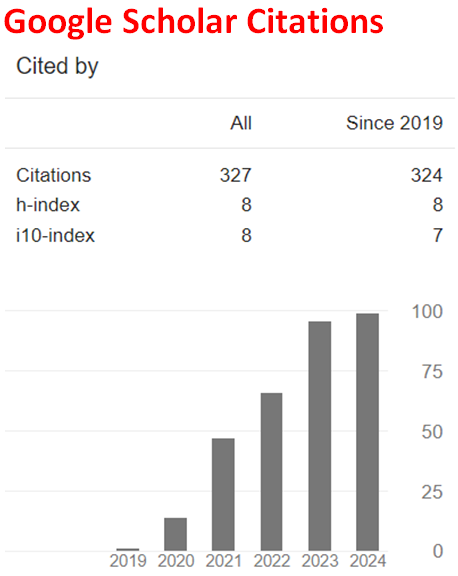Isomers and tautomers of aminonitroethylenes – A DFT study
Abstract
Aminonitroethylene isomers and their 1,3- and 1,5-proton tautomers are considered within the constraints of density functional theory at the level of B3LYP/6-311++G(d,p). Aminonitroethylene is a part of the well known explosive FOX-7 which is characterized with a pull-push type resonance. All the structures considered possess thermodynamically exothermic heat of formation values are, electronically stable, and have favorable Gibbs’ free energy of formation values at the standard states. Various quantum chemical properties, including IR and UV-VIS spectra, the HOMO and LUMO energies etc., have been obtained and discussed.
References
Kleinpeter, E. (2006). Push-pull alkenes: Structure and -electron distribution. Journal of the Serbian Chemical Society, 71(1), 1-17. https://doi.org/10.2298/JSC0601001K
Anslyn, E.V., & Dougherty, D.A. (2006). Modern physical organic chemistry. Sausalito, California: University Science Books.
Dykstra, C.E., Frenking, G., Kim, K., & Scuseria, G. (2015). Theory and applications of computational chemistry: The first forty years. New York: Elsevier.
Yanai, H., Suzuki, T., Kleemiss, F., Fukaya, H., Malaspina, L.A., Grabowsky, S., & Matsumoto, T. (2019). Chemical bonding in polarized push-pull ethylenes. Angewandte Chemie International Edition, 58(26), 8839-8844. https://doi.org/10.1002/anie.201904176
Shainyan, B.A., Fettke, A., & Kleinpeter, E. (2008). Push-pull vs captodative aromaticity. J. Phys. Chem. A, 112(43), 10895-10903. https://doi.org/10.1021/jp804999m
Pappalardo, R.R., Marcos, E.S., Ruiz-Lóapez, M.F., & Rinaldi D. (1991). Theoretical study of simple push-pull ethylenes in solution. Journal of Physical Organic Chemistry, 4(3), 41-148. https://doi.org/10.1002/poc.610040304
Politzer, P., Concha, M.C., Grice, M.E., Murray J.S., Lane, P., & Habibollazadeh, D. (1998). Computational investigation of the structures and relative stabilities of amino/nitro derivatives of ethylene. Journal of Molecular Structure (Theochem), 452, 75-83. https://doi.org/10.1016/S0166-1280(98)00136-5
Kleinpeter, E., Klod, S., & Rudorf, Wolf-Dieter. (2004). Electronic state of push-pull alkenes: An experimental dynamic NMR and theoretical ab ınitio MO study. J. Org. Chem., 69(13), 4317-4329. https://doi.org/10.1021/jo0496345
Ababneh-Khasawneh, M., Fortier-McGill, B.E., Occhionorelli, M.E., & Bain, A.D. (2011). Solvent effects on chemical exchange in a push-pull ethylene as studied by NMR and electronic structure calculations. J. Phys. Chem. A, 115(26), 7531-7537. https://doi.org/10.1021/jp201885q
Türker, L., Bayar, Ç.Ç., & Balaban, A.T. (2010). A DFT study on push-pull (amino-nitro) fulminenes and hexahelicenes. Polycyclic Aromatic Compounds, 30(2), 91-111. https://doi.org/10.1080/10406631003756005
Türker, L., & Bayar, Ç.Ç. ( 2010). A DFT study on disubstituted R-hexahelicenes having donor/acceptor groups. Procedia Computer Science, 1(1), 1155-1164. https://doi.org/10.1016/j.procs.2010.04.129
Stewart, J.J.P. (1989). Optimization of parameters for semi empirical methods I. Method. J. Comput. Chem., 10, 209-220. https://doi.org/10.1002/jcc.540100208
Stewart, J.J.P. (1989). Optimization of parameters for semi empirical methods II. Application. J. Comput. Chem., 10, 221-264. https://doi.org/10.1002/jcc.540100209
Leach, A.R. (1997). Molecular modeling (2nd ed.). Essex: Longman.
Fletcher, P. (1990). Practical methods of optimization (1st ed.). New York: Wiley.
Kohn, W., & Sham, L. (1965). Self-consistent equations including exchange and correlation effects. J. Phys. Rev., 140, 133-1138. https://doi.org/10.1103/PhysRev.140.A1133
Parr, R.G., & Yang, W. (1989). Density functional theory of atoms and molecules (1st ed.). London: Oxford University Press.
Cramer, C.J. (2004). Essentials of computational chemistry (2nd ed.). Chichester, West Sussex: Wiley.
Becke, A.D. (1988). Density-functional exchange-energy approximation with correct asymptotic behavior. Phys. Rev. A, 38, 3098-3100. https://doi.org/10.1103/PhysRevA.38.3098
Vosko, S.H., Wilk, L., & Nusair, M. (1980). Accurate spin-dependent electron liquid correlation energies for local spin density calculations: a critical analysis. Can. J. Phys., 58, 1200-1211. https://doi.org/10.1139/p80-159
Lee, C., Yang, W., & Parr, R. G. (1988). Development of the Colle-Salvetti correlation energy formula into a functional of the electron density. Phys. Rev., B, 37, 785-789. https://doi.org/10.1103/PhysRevB.37.785
SPARTAN 06, Wavefunction Inc., Irvine CA, USA, 2006.
Dewar, J.M.S. (1969). The molecular orbital theory of organic chemistry. New York: McGraw-Hill.
Dewar, M.J.S., & Dougherty, R.C. (1975). The PMO theory of organic chemistry. New York: Plenum/Rosseta.
Türker, L. (2004). Possibility of cyclic transition states of nitroglycerine. Theochem, 68, 15-19. https://doi.org/10.1016/j.theochem.2004.03.037
Türker, L. (2011). Recent developments in the theory of explosive materials, In T.J. Jansen (Ed.), Explosive materials, materials science and technologies. New York: Nova Science Pub.
Türker, L. (2009). Structure-impact sensitivity relation of certain explosive compounds. J. of Energetic Mater., 27, 94-109. https://doi.org/10.1080/07370650802405182
Reutov, O. (1970). Theoretical principles of organic chemistry. Moscow: Mir Pub.

This work is licensed under a Creative Commons Attribution 4.0 International License.


